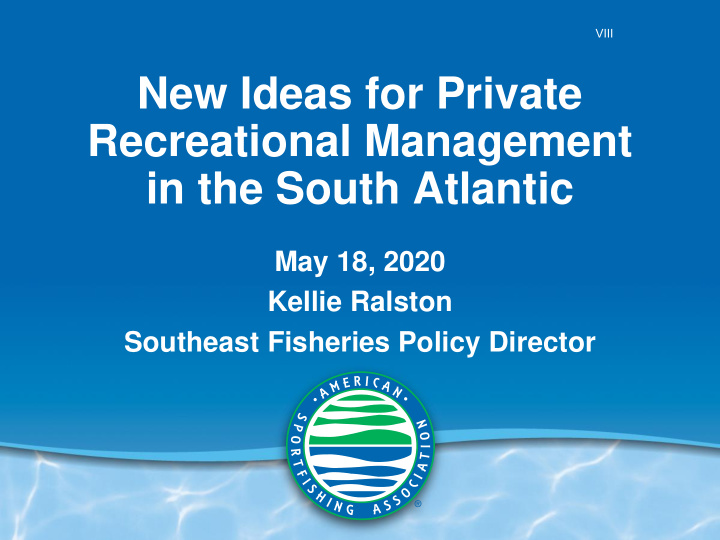



VIII New Ideas for Private Recreational Management in the South Atlantic May 18, 2020 Kellie Ralston Southeast Fisheries Policy Director
Project Overview American Sportfishing Association, Yamaha Marine Group and Coastal Conservation Association Council Workshop (September 2018) • Discussion and feedback on approaches for regional meetings Regional Meetings (Fall/Winter 2018/2019) • Recreational representative feedback Recommendations (March 2019) • Recommended actions for Council consideration
Topic Overview Harvest rate management Harvest tags for certain deepwater species Seasonal management* Regional differences Electronic recreational reporting Recreational registration or stamp Release mortality reduction**
Angler Preferences and Regional Variation What makes a good fishing trip? • Catch a lot of fish, keep enough to make the trip worthwhile • ‘Enough’ fish = keep one trophy fish and take some home • Sufficient opportunity to go fishing when it best suits the angler Important species: Red snapper, gag grouper, vermilion snapper, black sea bass and gray triggerfish A variety of harvestable fish allows anglers to keep “enough” fish by switching target species Restrictions on red snapper affect trip satisfaction due to discards and having to avoid red snapper to catch other species
Harvest Rate Management Uses exploitation rate targets to reach a desired rate of removal and stock biomass level Approach focuses on how Council monitors and responds to changes , and adjusts management to reach targets Allows response to changes in recreational effort and fish populations using most recent information Provides more stability and predictability Anglers were supportive of the outcomes of this approach Could be a useful tool for important species
Harvest Tags Tag issued for each fish to be harvested, as in game management More appropriate for species with low ACLs or naturally low abundance Can be used to improve data collection or control effort Anglers were supportive of harvest tags in limited applications Challenges : Fairness in how to distribute tags • Potential to restrict access for active • participants Potential for a pilot program to allow for selective distribution and # tags higher than the ACL
Angler Registration and Reporting Registration or stamp through states for anglers targeting snapper grouper species (open access) Better understand the number of anglers in the fishery Electronic reporting could be used to supplement MRIP Anglers were supportive of registration or a stamp and recreational reporting to define the “universe” targeting snapper grouper species and improve recreational data Anglers more likely to report if they understand how the data will be used and if they do not feel that the data will result in more restrictions
Final Recommendations The Council should consider regional regulations for appropriate species The Council should continue to explore harvest rate management for high value snapper grouper species The Council could consider an Exempted Fishing Permit for a pilot program to test harvest tags for certain deepwater species The Council should work with state partners to establish a registration for anglers targeting snapper grouper species, with consistency across all states The Council should continue development of Snapper Grouper Amendment 46 to implement required or selective reporting for anglers
Recreational Management Reform: A Harvest Control Rule Approach May 18, 2020 Michael Waine Atlantic Fisheries Policy Director
Presentation Outline Background Current Fishery Data and Management Harvest Control Rule Approach Submitted as part of Rec/comm allocation amendment • MAFMC/ASMFC Amendment HCR needs further development and acknowledge MSA challenges Next Steps and Questions
Recreational vs. Commercial Fishing
Recreational vs. Commercial Data
Recreational vs. Commercial Management Pound Based Quotas for Both Rec Management: Comm Management: Each state sets measures Quota set predicted to collectively Commercial measures achieve RHL control landings At the end of year, Once landings are reached compare MRIP catch fishery closed estimates to RHL Data system minimizes Accounting problems accounting problems because of uncertainty and time lag
In Comes New Effort Mail Survey Rec catch estimates generally higher all the way back to 1981 Model generally interprets increased catch with higher ABCs Example: Summer Flounder 2019 Recreational measures stay the same Commercial sector sees 62% increase in allowed landings. Wait, if our RHL increased how come our measures stayed the same? “You’re already catching it”
Harvest Control Rule Approach If we can’t manage the uncertainty of MRIP, can we tweak the management system to account for that uncertainty? Premise of HCR: access (allocation) can be defined for the recreational sector as a combination of size limits bag limits seasons Relatable to commercial allocation in pounds because access can be more or less restrictive based on stock condition
Harvest Control Rule: The endpoints Stock Recreational Commercial Condition Least restrictive measures Highest quota Healthy maximizes access and market and landing capacity is participation met Allows for growth Asymptotic market price Allows for growth Most restrictive measures Lowest quota Poor Lowest access & Loss of markets no supply participation Not enough pounds to justify trips Loss of infrastructure Loss of shore side processing Loss of for-hire business because “not worth it to pay to go fishing”
Harvest control Rule Concept
HCR Analysis Phase Pull management history Pull recreational removals data Match that management and removals history to stock status in each step Analyze the range of alternatives Demonstrate HCR through at least 2- 3 year cycles
What about accountability? Management measures would move stepwise with stock condition Possibility to be proactive, if assessment or indices indicate stock condition is in continuous decline (e.g., 3 years) then move to lower step Review Timeline Besides triggering review as part of accountability, fixed review timeframe (e.g., every 5 years).
HCR Summary and Next Steps HCR in need of further development Stakeholder involvement critical HCR adjusts access (management measures) to stock condition just like an ACL does Approach brings more stability to fishery and management Submitted as part of scoping on Recreational/Commercial allocation amendment
Recommend
More recommend